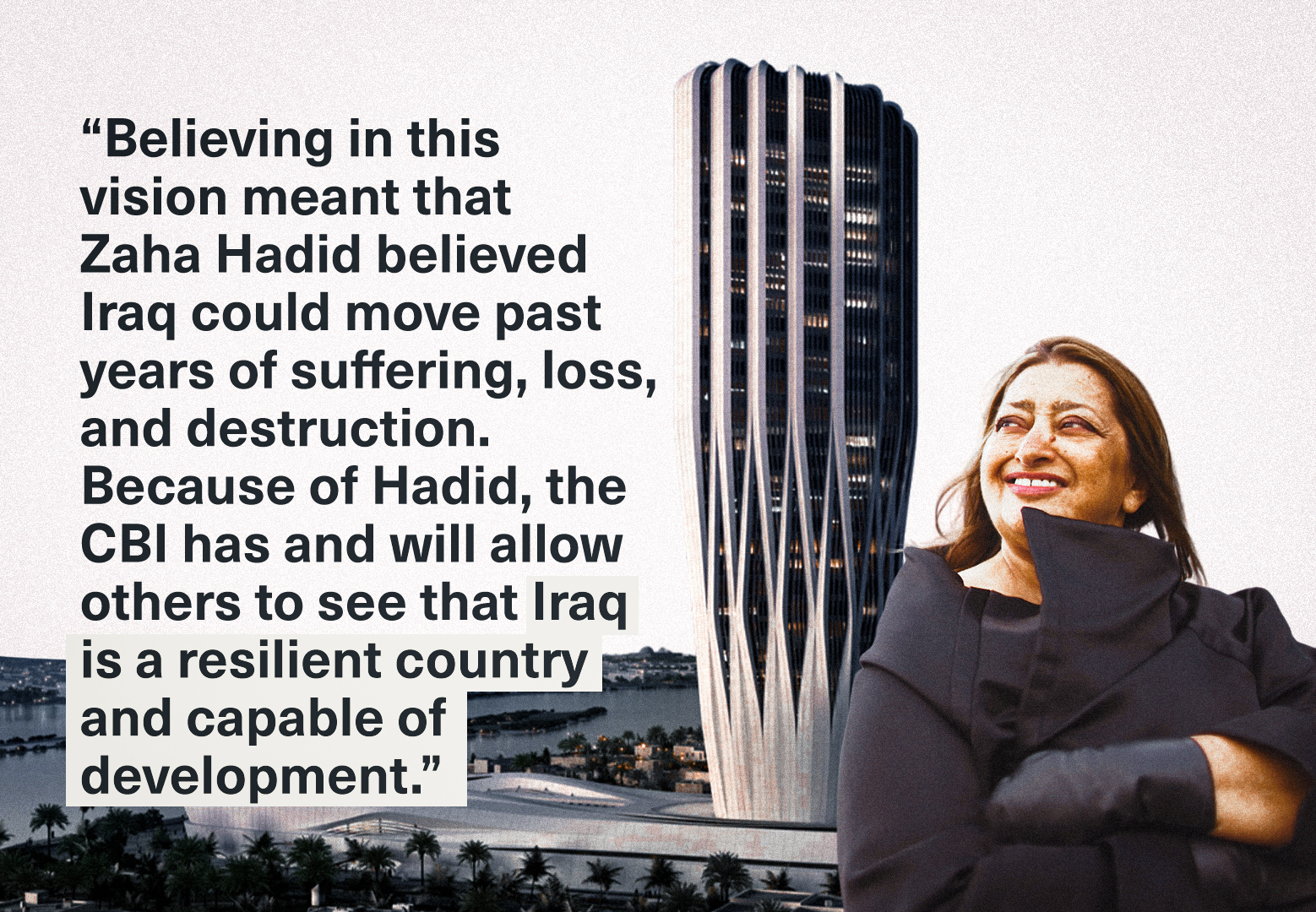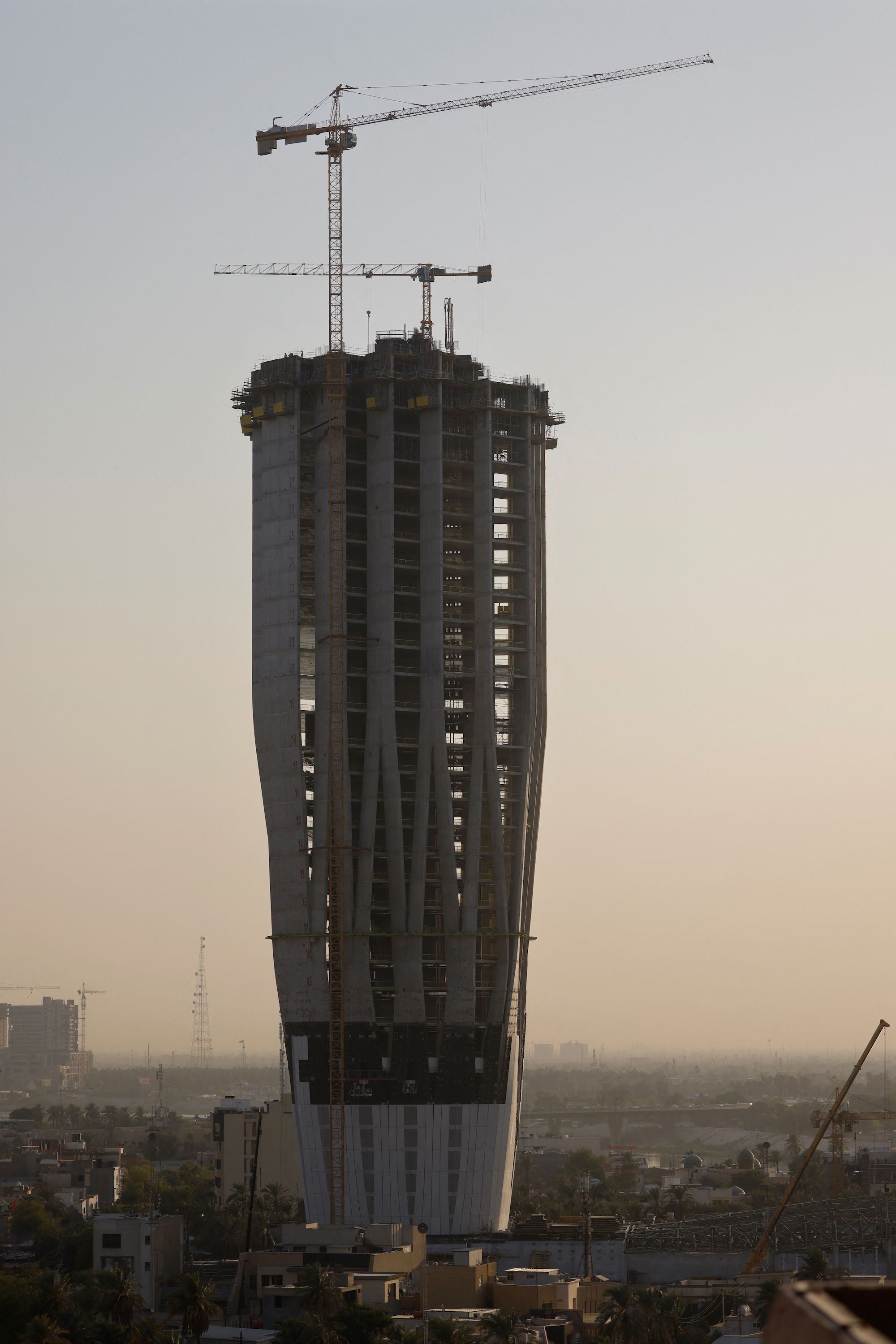
Zaha Hadid: The 'Queen of the Curve' and the Central Bank of Iraq

Depending on Covid-19 and security challenges in Iraq, Baghdad will see the long-awaited completion of the 170-m tall Central Bank of Iraq (CBI) tower designed by late British Iraqi architect Zaha Hadid.
Before Hadid’s passing, the architect, in response to being appointed for the tower design said:
“I am deeply touched that I have been asked to design the new headquarters for the Central Bank of Iraq. I was born in Iraq, and I still feel very close to it. I feel very privileged to be working in Iraq on a design of such national importance.”
The design appointment – which included concept designs and tender documents – started from December 2012 to December 2014, explains Jim Heverin, Zaha Hadid Architects Project Director of the CBI.
Acting as the lead consultant for the project, Zaha Hadid Architects appointed a full design team for approximately 22 different services provided by sub-consultants such as the famous Max Fordham MPE, AK II structural engineers, Arup, and Davis Langdon.
In terms of construction, Dhirgham M. Alobaydi, Chair of the Department of Architecture at the University of Baghdad, notes that offers were sent to four different companies. DAAX Construction, a construction and contracting company based in Azerbaijan were selected. In terms of supervision, Sydney-based CME/Meinhardt won.
|
|
Throughout the course of the project, planning for the CBI tower has witnessed a number of low points in terms of confidence, trying to convince people that this project is possible and that security hardship will pass, especially in 2015 at the height of the Islamic State (IS) group's occupation of Iraq.
According to Heverin, it was a real challenge at the time of the Islamic State's domination over Iraq, asking foreign contractors whether they would consider working on a project in a country that was considered a warzone.
Despite the hesitation that the project witnessed, current building efforts signify a new phase of construction in a flourishing and developing Baghdad.
| This picture taken in Baghdad on August 27, 2021, shows the construction of the Central Bank of Iraq building [Getty] |
For this project, Hadid focused on constructing a tower that spoke volumes in terms of reviving the new life of the country and symbolising an emblem of the new Iraq. Indeed, the new CBI headquarters will support the monetary authority of the CBI to execute its continued responsibility of providing growth, economic development, stability, and security.
The latter feature is significant especially when bearing in mind the attack by suicide bombers and gunmen on the complex on June 13, 2010. The assault, which left 15 citizens dead, saw bombers blowing themselves up whilst gunmen fought with bank security officers.
Taking heightened security measures into account, the design features include bomb blast security and attack resistance. Specifically speaking, the tower will see the incorporation of glass fibre reinforced concrete (GRC) panels in the tower and the use of ultra-high performance concrete (UHPC) in the entire structure of the building. These materials in particular support security defences and external penetrations due to the height, strength and durability of the panels.
Criticised on a number of occasions for lacking environmental sensibilities, Hadid and employees working on the tower have made sure to embrace sustainability through the incorporation of climate-friendly materials. Consisting of a solid concrete shell at the base, and a series of petal-shaped columns in its opening, sustainable technologies at the CBI are accomplished via the use of materials such as smart glass and pollution-resistant cement, which are both known to have little effect on the environment.
"Hadid passed away far too soon and deserves to be celebrated for the large volume of work she accomplished and transforming the world of architecture via her drawings, paintings, and designs"
The incorporation of sophisticated architectural techniques such as the double façade is also noteworthy. This specific design helps to increase energy efficiency, thus helping to control solar gains, night-time cooling, and reduce heating demand. Such advantages not only provides natural-cross ventilation, but also reduce wind and sound effects, sustains exceptional daylight levels and outside views, and act as a barrier to pollution.
Bearing these technological factors in mind, Hadid’s involvement with the CBI has helped aid Iraq’s reconstruction efforts in more ways than one. Not only is the country rebuilding itself after years of devastation, but also establishing a new identity for itself with its own conditions.
Whilst Hadid’s childhood has more reverberation with Iraqi culture, her style of design cannot be considered ‘Iraqi,’ but modernist instead. The celebrated architect created lofts bound to technological cores as a commemoration of the new. Hadid had no truck with typologies, applied orders, implicit statements, or gravity: she understood that we could and should construct an improved world, one marked by freedom, above all else.
| Zaha Hadid believed Iraq could move past years of suffering, loss, and destruction [Getty] |
In fact, Gropius had quite the opposite architectural approach to Hadid. As a key figure of the Bauhaus generation, Gropius’s university design uses simple geometric shapes like rectangles, without the complicated designs that Hadid incorporated.
Regardless of the difference in style, however, both the CBI tower and the University of Baghdad deserve to be celebrated as civic symbols. Resembling what looks like a palm tree, the location of the CBI tower, which is right at the banks of the Tigris River, not only complements the river’s historic importance, but also the other monumental buildings located nearby.
One example is that of the Walter Gropius’s University of Baghdad. Also considered to be a modernist of his time, Gropius’s university design differs from Hadid’s futuristic style characterised by sharp angles and curving facades.
Hadid’s additional vision of believing that we should be liberated from the past, limitations of social convention, physical laws, and our bodies, made her the perfect candidate for designing the CBI tower. Believing in this vision meant that Hadid believed Iraq could move past years of suffering, loss, and destruction. Because of Hadid, the CBI has and will allow others to see that Iraq is a resilient country and capable of development.
Commenting on the significance of the project, Heverin explains that: “People will see and believe in the project. It’s kind of tangible in the sense of progress in a city that has suffered a lot and at times, struggled to see the tangible benefits for when people are struggling to obtain water, power, and basic utilities, as well as basic safety. So, I think now that the project is emerging in Baghdad, there is an appreciation of the ambition of the project.”
Appreciation for the project has involved the soon emerging economic opportunities. According to a site engineer working on CBI construction efforts, this large project will prove to the world that Iraq is becoming a safe environment for investment and foreign companies to work and meet Iraq’s urgent needs in terms of infrastructure development and developing residential complexes. With this in mind, the project will provide job opportunities to help solve employment issues, a key grievance expressed during the 2019-2021 Iraq protests.
| A portrait of the renowned architect is seen in the sky lounge of the One Thousand Museum building in Miami [Getty] |
In the coming years, it will be unfortunate that Hadid will not be able to see the only project she envisioned for her home country. Hadid passed away far too soon and deserves to be celebrated for the large volume of work she accomplished and for transforming the world of architecture via her drawings, paintings, and designs.
Hadid, also known as a Dame, generated designs from taps, boats, and skyscrapers to urban plans around the globe. She kept on pushing, all the way to the end, and her buildings, still soaring or to come, and her impact, especially within the Architectural Association in London, continues to blossom and evolve.
Zainab Mehdi is a Researcher and Freelance Journalist specialising in governance, development, and conflict in the Middle East and North Africa region.
Follow her on Twitter: @zaiamehdi
This article is part of a special series called Arabs in the UK: An exciting new project that sheds light on the Arab population in the United Kingdom and aims to showcase their continuing contributions to communities. Follow here to read more articles from this series:







